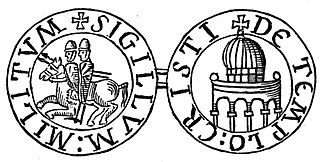
The Poor Fellow-Soldiers of Christ and of the Temple of Solomon, mainly known as the Knights Templar, was a military order of the Catholic faith, and one of the wealthiest and most popular military orders in Western Christianity. They were founded c. 1119, headquartered on the Temple Mount in Jerusalem, and existed for nearly two centuries during the Middle Ages.
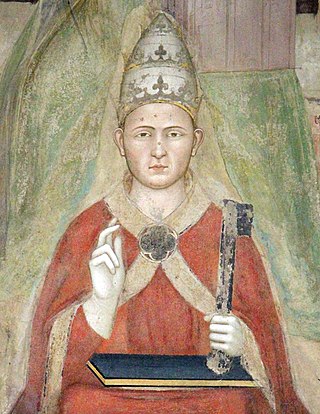
Pope Clement V, born Raymond Bertrand de Got, was head of the Catholic Church and ruler of the Papal States from 5 June 1305 to his death, in April 1314. He is remembered for suppressing the order of the Knights Templar and allowing the execution of many of its members. Clement moved the Papacy from Rome to Avignon, ushering in the period known as the Avignon Papacy.

The Eighth Crusade was the second Crusade launched by Louis IX of France, this one against the Hafsid dynasty in Tunisia in 1270. It is also known as the Crusade of Louis IX Against Tunis or the Second Crusade of Louis. The Crusade did not see any significant fighting as King Louis died of dysentery shortly after arriving on the shores of Tunisia. The Treaty of Tunis was negotiated between the Crusaders and the Hafsids. No changes in territory occurred, though there were commercial and some political rights granted to the Christians. The Crusaders withdrew back to Europe soon after.

The Seventh Crusade (1248–1254) was the first of the two Crusades led by Louis IX of France. Also known as the Crusade of Louis IX to the Holy Land, it aimed to reclaim the Holy Land by attacking Egypt, the main seat of Muslim power in the Near East. The Crusade was conducted in response to setbacks in the Kingdom of Jerusalem, beginning with the loss of the Holy City in 1244, and was preached by Innocent IV in conjunction with a crusade against emperor Frederick II, Baltic rebellions and Mongol incursions. After initial success, the crusade ended in defeat, with most of the army – including the king – captured by the Muslims.
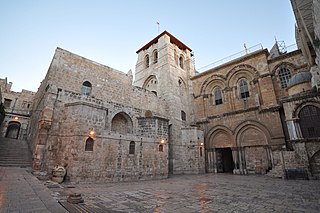
The crusading movement was a framework of ideologies and institutions that described, regulated, and promoted the Crusades. These were a series of religious wars initiated, supported, and sometimes directed by the Christian Latin Church in the Middle Ages. Members of the Church defined the movement in legal and theological terms based on the concepts of holy war and pilgrimage. Theologically, the movement merged ideas of Old Testament wars that were instigated and assisted by God with New Testament ideas of forming personal relationships with Christ. Crusading was a paradigm that grew from the encouragement of the Gregorian Reform of the 11th century and the movement declined after the Reformation. The ideology continued after the 16th century, but in practical terms dwindled in competition with other forms of religious war and new ideologies.
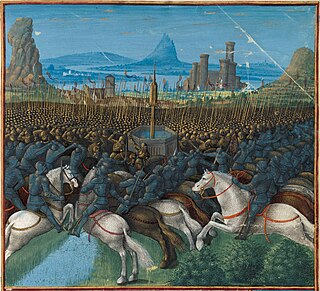
The Battle of Cresson was a small battle between Frankish and Ayyubid forces on 1 May 1187 at the "Spring of the Cresson." While the exact location of the spring is unknown, it is located in the environs of Nazareth. The conflict was a prelude to decisive defeat of the Kingdom of Jerusalem at the Battle of Hattin two months later.

The Crusades were a series of religious wars initiated, supported, and sometimes directed by the Christian Latin Church in the medieval period. The best known of these military expeditions are those to the Holy Land in the period between 1095 and 1291 that were intended to reconquer Jerusalem and its surrounding area from Muslim rule. Beginning with the First Crusade, which resulted in the conquest of Jerusalem in 1099, dozens of military campaigns were organised, providing a focal point of European history for centuries. Crusading declined rapidly after the 15th century.

Guillem or Guilhem Figueira or Figera was a Languedocian jongleur and troubadour from Toulouse active at the court of the Emperor Frederick II in the 1230s. He was a close associate of both Aimery de Pégulhan and Guillem Augier Novella.
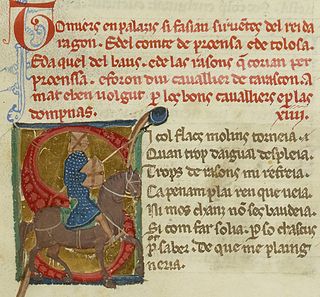
Tomier and Palaizi were two knights and troubadours from Tarascon, possibly brothers, and frequent comrades and co-composers.
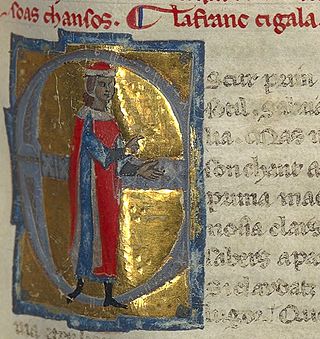
Lanfranc Cigala was a Genoese nobleman, knight, judge, and man of letters of the mid thirteenth century. He remains one of the most famous Occitan troubadours of Lombardy. Thirty-two of his poems survive, dealing with Crusading, heresy, papal power, peace in Christendom, and loyalty in love. Lanfranc represented a tradition of Italian, Occitan-language trovatori who berated the Papacy for its handling of the Crusades.

Peirol or Peiròl was an Auvergnat troubadour who wrote mostly cansos of courtly love in the late twelfth and early thirteenth centuries. Thirty-four surviving poems written in Occitan have been attributed to him; of these, seventeen have surviving melodies. He is sometimes called Peirol d'Auvergne or Peiròl d'Auvèrnha, and erroneously Pierol.
Olivier lo Templier was a Knight Templar and troubadour probably from Catalonia. He appears as lo templier En'Olivier in one chansonnier, in which is preserved his only known work, Estat aurai lonc temps en pessamen. He may be identical with Ramon Oliver who appears as commander of the Templar house of Gardeny near Lleida in 1295. He should not be confused with another troubadour Templar, Ricaut Bonomel, whose style was very different and who wrote from the Holy Land.
Guilhem d'Autpol or Daspol was a troubadour from Hautpoul in the Languedoc. He wrote four works that survive, three dwelling on intensely religious themes. There exists some evidence internal in his songs that he was a jongleur early on.
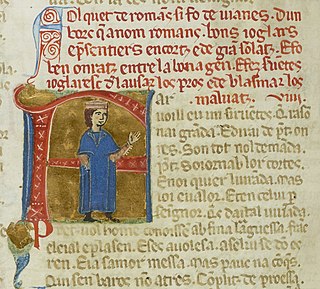
Falquetde Romans was the most famous troubadour attached to the court of Frederick II, Holy Roman Emperor, where he garnered a high reputation despite the fact that his career began as a jongleur. His surviving work consists of fourteen or fifteen pieces: seven sirventes, three tensos, two or three cansos on courtly love, a salut d'amor of 254 lines, and a religious alba. His poetry is, in general, clear and elegant, and he was apparently very religious.
Austorc d'Aorlhac or Aurilhac was an Auvergnat troubadour from whom only one sirvente survives. He was from Aurillac.
Austorc de Segret or Austau de Segret was an Auvergnat troubadour with only one surviving sirventes, "No sai quim so, tan sui desconoissens".
Guilhem or Guillem Fabre was a troubadour and burgher from Narbonne. He may be the same person as the dedicatee of En Guillems Fabres, sap fargar, a eulogistic poem by Bernart d'Auriac. He was one of several mid- to late-thirteenth-century troubadours from Narbonne, with Bernart Alanhan and Miquel de Castillon.

In 1307, members of the Knights Templar in the Kingdom of France were suddenly charged with heresy and arrested after their leader, Master Jacques de Molay, had recently come to France for meetings with Pope Clement V. Many, including their leader, were burned at the stake while others were sentenced to perpetual imprisonment. The events in France led to a series of trials in other locations, not all of which had the same outcome.

The timeline of the Kingdom of Jerusalem presents important events in the history of the Kingdom of Jerusalem—a Crusader state in modern day Israel and Jordan—in chronological order. The kingdom was established after the First Crusade in 1099. Its first ruler Godfrey of Bouillon did not take the title of king and swore fealty to the Latin Patriarch of Jerusalem, Daimbert. Godfrey's brother and successor Baldwin I was crowned the first king of Jerusalem without doing homage to the patriarch in 1100. By 1153, Baldwin I and his successors captured all towns on the Palestinian coast with the support of Pisan, Genoese and Venetian fleets and also took control of the caravan routes between Egypt and Syria. The kings regularly administered other crusader states—the Counties of Edessa and Tripoli and the Principality of Antioch—on behalf of their absent or underage rulers.